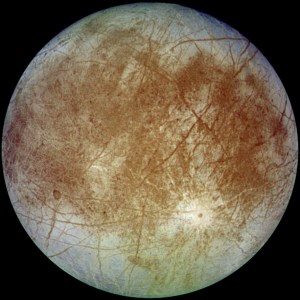Hey everyone. I’m in central Australia working on a seismic survey crew at the moment so my blogs will become a little less frequent, but luckily I still have (limited) internet connection so I can still post!
I just finished watching Europa Report, which was, overall, quite entertaining. Without giving away too much just yet, it’s a movie about the first human mission beyond the moon. A crew of 6 are sent to test whether life exists on the or under the icy surface of one of Jupiter’s moons, Europa.
A tale of human sacrifice, one of the more memorable quotes was “Compared to the breadth of knowledge yet to be known, what does your life actually matter?” I too have wondered this, and as a scientist I easily sympathise with the sentiment. I would gladly lay down my life for science, and often wonder what I would do and sacrifice in the face of overwhelming odds if I were chosen for a manned Mars mission (I think it’s likely Mars will happen before Europa!).
I definitely appreciated the cameo appearance of Neil deGrasse Tyson talking about a mission to Europa, even if not originally filmed for the movie.
Despite this moving quote and underlying theme, there were just far too many scientific flaws for me to ignore. I’m used to seeing unrealistic technology in sci-fi movies, but not blatant breaking of the laws of physics.
— SPOILER ALERT —
First, the crew were maintaining near instantaneous communication with their control centre on Earth for much of the mission. As far as several months into the journey, near Mars, there did not seem to be any delay in voice. Light takes as little as 4 minutes to travel from Earth to Mars (then 4 minutes back) and as much as 24 minutes. Even at the Moon the delay would be about 1 second either way. But that’s ok, maybe humanity in this near-future society has found a way to achieve faster than light communication.

Once the crew landed on Europa, I was looking forward to seeing the crew float around in the low gravity. Europa does have the mass of about 0.008 Earths after all, giving a gravity of 1.3 m/s/s, slightly lower than our own moon’s. Nope. They were stomping about and lugging equipment like they were being accelerated at a casual 9.8 m/s/s.
Speaking of landing on Europa, why did they need to send five crew members to the surface anyway? Why did they need to send anyone down? Surely the whole sample collection mission could have been done with robotics. But then if that’s the case, why send humans to Europa in the first place? The only benefit would be that humans could have a quicker response time to tweak the robotics and react to problems. But even that seems like an unduly large risk.
Last, the crew, especially the science team, spent way too much dialogue talking about how they were going to run tests or analysis on data they had just acquired (Which yielded ground breaking results in seconds. So much for data quality control!). Groan. People look at me strange when I start saying that in a lab!
Besides all that it was an enjoyable 90 minutes! But I wouldn’t watch it again. 7/10.